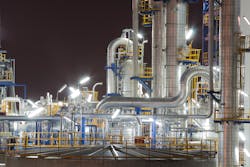Selecting the right valve in a chemical processing application is extremely important. Polyvinyl chloride (PVC) valves are used in a variety of systems, and most are not industry specific. There are many options to choose from, including ball valves, butterfly valves, check valves, gate valves and diaphragm valves. With a variety of options available, factors need to be considered, including the material of the valve being used, temperature and pressure requirements, flow control, and fluid type. This article discusses PVC and chlorinated PVC (CPVC) valves in chemical processing.
Common types of PVC valves for chemical processing
When choosing a PVC valve for chemical processing, there are many options depending on the application. Ball valves, for instance, incorporate a rotating ball into a quarter-turn valve, which can either block flow completely or allow it to move downstream. Ball valves can be selected based on their specific degree of flow regulation. Most come with a lever or handle, which serves as a visual for the direction and status of the valve. Use PVC ball valves in applications where flow must be easily shut off, including high-pressure hydraulic systems and compressed air lines.
Butterfly valves are also quarter-turn valves. They utilize circular flaps that swing into or out of the flow stream for regulation of flow. Manual butterfly valves use a handle for adjustment, while gear valves, made for larger lines, utilize a wheel. They are not as effective as ball valves in high-pressure applications, but they are less expensive. Butterfly valves are commonly used in wastewater plants, processing plants and chemical processing, as well as larger diameter pipelines.
For applications where flow is moving in a single direction, check valves may be the best option. There are several types of check valves on the market today. Swing check valves use hinged gates or wafers activated by a spring to close ports as pressure decreases. They are more common in low-pressure systems. Lift-type check valves, on the other hand, use a ball or piston, combined with a spring, to open at a specific pressure and close when the pressure decreases.
While other valves regulate flow, gate valves are used to completely block flow when necessary. They utilize a plate-like barrier, which is lowered into the stream to completely shut off flow. However, flow remains consistent when the valve is fully opened. Some gate valves are rising stems, which means the operator can see when the valve is open. While this can be a useful feature, it also leaves the valve exposed to the elements when open. Nonrising stem gate valves are also available.
Diaphragm valves are also extremely effective at blocking flow. This option uses flexible membranes to completely seal off sections of piping, allowing the actuator and the process fluid to remain separate. Diaphragm valves provide a nearly leakproof seal, which makes it the right fit for pharmaceutical, cosmetic and food processing.
How to choose the right valve
Key considerations to keep in mind when selecting a valve include the material of the valves, any pressure and temperature requirements, the need for flow control, and the type of fluid flowing through the valves.
Material of construction
When choosing the right valve for a specific chemical processing application, it is important to consider not just the functionality of the valve, but also the material. Most valves can be manufactured in both PVC and CPVC. Valves made of PVC are a cost-effective option with strong resistance to sunlight, oxidation and chemicals, including acids, bases, salt solutions and organic solvents. They are lightweight and strong. CPVC valves are also resistant to most chemicals, with the added benefit of having a higher heat resistance and pressure handling. However, CPVC valves are more expensive than their PVC counterparts.
Temperature and pressure requirements
When selecting plastic valves like PVC or CPVC, it is extremely important to determine temperature and pressure requirements. Selecting the wrong valve for the job could diminish the functionality and cause additional problems on the line. CPVC valves should always be used when consistently higher temperatures and pressures are expected. Some valves, like ball valves, can be used in higher pressure situations and can even be selected based on specific pressures, while others, like the butterfly valve, may not be well-suited for high-pressure applications.
Flow control
Consider the design of the system and the flow control needed. For instance, ball and butterfly valves are effective in both vertical and horizontal lines, while check valves will only work vertically if the flow is moving upward. In addition, some valves are better suited for regulating flow, while others, like the gate and diaphragm, are specifically designed to stop flow.
Type of fluid
Fluid type is also an important factor in determining which valve is best, especially in chemical processing. Butterfly valves, for instance, may not be the best choice for fluids containing particulates. They are, however, easy to remove, clean or replace, which is especially helpful when dealing with potentially corrosive liquids.
4 reasons CPVC valves are suited for chemical processing
While PVC and metal valves are commonly used in other applications, CPVC offers advantages for chemical processing systems. The reasons for this include:
- CPVC valves are easier to work with. They are lightweight and, unlike metal valves, welding is not needed.
- CPVC valves cost less than metal valves. Because they are easier to work with, labor costs are often much less with CPVC valves. In addition, because of their chemical resistance, maintenance and replacement costs are less.
- CPVC valves can handle higher temperatures and higher pressures. Unlike PVC valves, which can withstand temperatures reaching 140˚, CPVC valves are designed to withstand 210˚. They will also maintain higher pressures and will not cause pressures to drop like their metal counterparts.
- CPVC valves are resistant to many chemicals and corrosives. It is always important to check the manufacturer’s specifications, but most CPVC valves can handle acids, bases and salts that could lead to leaks and damage in metal systems.
PVC and CPVC valve use in industrial applications
With many options available for valves in chemical processing, it can be challenging to select the right option. First, consider the material of the valve. Both PVC and CPVC valves are chemical resistant, lightweight and strong. CPVC valves, however, can withstand much higher temperatures and higher sustained pressures. Choose a valve with the right flow control for the application. Some, like the ball, butterfly and check valves, help regulate flow, while gate and diaphragm valves effectively close the line, stopping flow completely. Consider the type of liquid passing through the pipeline. Fortunately, CPVC valves are resistant to most chemicals, unlike their metal counterparts. As always, it is important to check the manufacturer’s specifications to be sure that the valve selected can withstand the unique conditions of the chemical processing application.Mark Ligon is the marketing manager at Commercial Industrial Supply, a supplier of commercial PVC and CPVC pipe, fittings and valves. Ligon enjoys educating businesses on the parts of piping systems so managers can make informed decisions. He can be reached at [email protected]. For more information, visit commercial-industrial-supply.com.
Editor’s Note: This article has been revised and updated for clarity since its original publication.
Mark Ligon
Mark Ligon is the marketing manager at Commercial Industrial Supply, a supplier of commercial PVC and CPVC pipe, fittings and valves. Ligon enjoys educating businesses on the parts of piping systems so managers can make informed decisions. He can be reached at [email protected]. For more information, visit commercial-industrial-supply.com.



